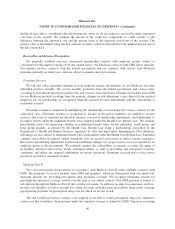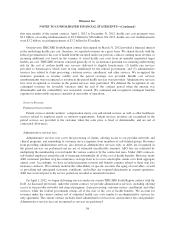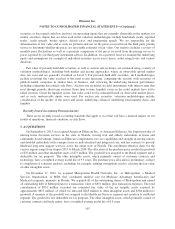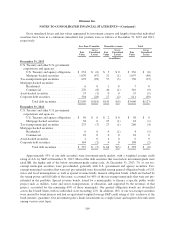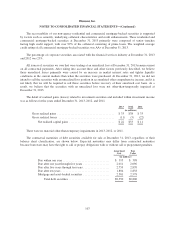Humana 2013 Annual Report Download - page 111
Download and view the complete annual report
Please find page 111 of the 2013 Humana annual report below. You can navigate through the pages in the report by either clicking on the pages listed below, or by using the keyword search tool below to find specific information within the annual report.Humana Inc.
NOTES TO CONSOLIDATED FINANCIAL STATEMENTS—(Continued)
Future policy benefits payable
Future policy benefits payable include liabilities for long-duration insurance policies including long-term
care, life insurance, annuities, and certain health and other supplemental policies sold to individuals for which
some of the premium received in the earlier years is intended to pay anticipated benefits to be incurred in future
years. At policy issuance, these reserves are recognized on a net level premium method based on interest rates,
mortality, morbidity, and maintenance expense assumptions. Interest rates are based on our expected net
investment returns on the investment portfolio supporting the reserves for these blocks of business. Mortality, a
measure of expected death, and morbidity, a measure of health status, assumptions are based on published
actuarial tables, modified based upon actual experience. Changes in estimates of these reserves are recognized as
an adjustment to benefits expense in the period the changes occur. We perform loss recognition tests at least
annually in the fourth quarter, and more frequently if adverse events or changes in circumstances indicate that the
level of the liability, together with the present value of future gross premiums, may not be adequate to provide
for future expected policy benefits and maintenance costs. We adjust future policy benefits payable for the
additional liability that would have been recorded if investment securities backing the liability had been sold at
their stated aggregate fair value and the proceeds reinvested at current yields. We include the impact of this
adjustment, if any, net of applicable deferred taxes, with the change in unrealized investment gain (loss) in
accumulated other comprehensive income in stockholders’ equity. As discussed above, beginning in 2014, health
policies sold to individuals that conform to the Health Care Reform Law are accounted for under a short-duration
model under which policy reserves are not established because premiums received in the current year are
intended to pay anticipated benefits in that year.
Book Overdraft
Under our cash management system, checks issued but not yet presented to banks that would result in
negative bank balances when presented are classified as a current liability in the consolidated balance sheets.
Changes in book overdrafts from period to period are reported in the consolidated statement of cash flows as a
financing activity.
Income Taxes
We recognize an asset or liability for the deferred tax consequences of temporary differences between the tax
bases of assets or liabilities and their reported amounts in the consolidated financial statements. These temporary
differences will result in taxable or deductible amounts in future years when the reported amounts of the assets or
liabilities are recovered or settled. We also recognize the future tax benefits such as net operating and capital loss
carryforwards as deferred tax assets. A valuation allowance is provided against these deferred tax assets if it is more
likely than not that some portion or all of the deferred tax assets will not be realized. Future years’ tax expense may
be increased or decreased by adjustments to the valuation allowance or to the estimated accrual for income taxes.
We record tax benefits when it is more likely than not that the tax return position taken with respect to a
particular transaction will be sustained. A liability, if recorded, is not considered resolved until the statute of
limitations for the relevant taxing authority to examine and challenge the tax position has expired, or the tax
position is ultimately settled through examination, negotiation, or litigation. We classify interest and penalties
associated with uncertain tax positions in our provision for income taxes.
Derivative Financial Instruments
At times, we may use interest-rate swap agreements to manage our exposure to interest rate risk. The
differential between fixed and variable rates to be paid or received is accrued and recognized over the life of the
agreements as adjustments to interest expense in the consolidated statements of income. We were not party to
any interest-rate swap agreements in 2013, 2012, or 2011.
101







